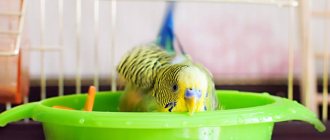Probably every hamster owner has noticed how this little lump combs its fur with its paws several times a day. This tells us that hamsters are fairly clean rodents and, in most cases, are able to clean themselves. In the wild, hamsters live in deserts and steppes, with virtually no water. Therefore, the best and most common cleaning method for them is sand. But is it possible to bathe hamsters in water at home?
It should be remembered that swimming in water can be quite dangerous for hamsters. In order not to harm your pet, you need to follow some rules when bathing.
How to bathe hamsters correctly
Since the usual habitat of hamsters is the steppe and desert, it should be understood that swimming in water in such an environment is almost impossible. Therefore, when answering the question of whether hamsters are washed, it should be emphasized that real bathing with water is not advisable for a hamster.
In order to clean the rodent of dirt, a simpler and less stressful method may be suitable. To do this you will need a damp cotton swab. It is best to keep the napkin warm. Cotton wool and simple wet baby wipes without chemical impregnations are also suitable. Take the rodent in your hands and wipe it thoroughly with a napkin; if the pet is very dirty, repeat the procedure several times.
After washing, dry the fur well and place the rodent in a warm place so that it does not catch a cold.
If we talk about bathing in water, the procedure itself is quite simple, but you need to be extremely careful and attentive so as not to harm your pet’s health.
Basic recommendations on how to bathe hamsters include:
- First you need to prepare water and a place for swimming, or rather for washing. The water should be warm, closer to room temperature. For washing, you need to prepare a flat surface (for example, a board) placed above the bathtub;
- The hamster should be placed on the surface and, holding it with one hand, little by little water with warm water. You need to water everything except the head, and it is important to ensure that water does not get into the eyes and ears;
- You should wash the rodent only with your hands, without using other objects;
- You can bathe your hamster using only a special shampoo for rodents, which can be purchased at any pet store. Baby shampoo with minimal chemical additives is also suitable;
- During bathing, loud and sharp sounds should not be allowed so as not to frighten the rodent. While bathing, talk to your pet, he knows your voice, try to do it in a calm and soft tone. It must be remembered that bathing is stressful for the animal;
- When finishing bathing, you should completely rinse off the shampoo from the rodent, as its residue can cause itching and irritation of the skin;
- During and after bathing, you should make sure that there are no drafts, since at this time the hamster’s immunity is weakened due to damage to the protective fatty membrane. Therefore, a small body is especially susceptible to colds;
- After washing the rodent, dry it with a towel or napkin; if necessary, you can use a hairdryer. His body should be very carefully dipped in a towel, absorbing moisture so as not to damage the thin bones.
Rodent hygiene
In addition, pets go to the toilet only in a certain place, so the litter remains clean for a long time. There are several reasons why an animal may emit an unpleasant odor:
- dirty cage;
- pet illness;
- contamination with materials that are difficult for a rodent to clean on its own.
In accordance with sanitary standards, the cage must be cleaned once a day and once a week - disinfected with boiling water. The filler also plays an important role - granulated bedding or fresh sawdust are best suited for hamsters. This material absorbs odor well and will not cause contamination of the animal.
How hamsters clean their own fur
At home, for this purpose, a bathing suit with a mixture of sand and chalk is installed in the cage. Similar material can be purchased at the store.
The animal enthusiastically buries itself in the sand, thereby cleaning its fur from dirt. After the procedure, the pet needs to be brushed off excess grains of sand with a toothbrush. After washing, hamsters may begin to use sand as a toilet, so the container should be removed.
This procedure should be carried out no more than twice a month, since frequent swimming in the sand can lead to debris getting into the pet’s organs of vision and blindness. Sand can also get into the hamster's respiratory tract and impair lung function.
Cleaning in the sand is a common thing for these rodents, but the question of whether it is possible to bathe a hamster in running water is difficult to answer unequivocally. On the one hand, there are situations in which the animal cannot clean itself without outside help, but on the other hand, water procedures can cause harm to the pet.
Rodents are not waterfowl, so when asked whether it is possible to bathe Syrian and Djungarian hamsters, veriners give ambiguous answers. The Syrian hamster lives in natural conditions where there are practically no large bodies of water. Often, rodent owners use a deep container in which the animal cannot reach the bottom to wash their hamster.
There is a misconception that pets like to swim and dive, but what makes them swim is survival instinct, not pleasure. For steppe jungarians, water is a less exotic phenomenon, but these rodents also do not swim in bodies of water.
What you need for swimming
- special anti-flea shampoo for rodents;
- a small container that will fit your pet;
- toothbrush or fine comb;
- towel.
This procedure cannot be carried out more than twice a year. When asked whether it is worth bathing hamsters more often, veterinarians answer - no. Frequent exposure of the fur of such animals to water disrupts the skin microflora and this can cause ulcers and irritation.
Before washing your hamster, certain conditions should be created. There are several rules that will minimize damage to the animal:
- Water should be at room temperature
- Make sure that the liquid does not get on the rodent's face, in particular, in the ears and eyes.
- Do not use your own personal care products or soap when bathing your hamster.
- After the procedure, the animal must be dried.
The last point is especially acute for the Syrian breed. These desert dwellers do not tolerate hypothermia well, and their long fur can take a long time to dry. In turn, dzhungarikas do not need to be dried for a long time, but you should not release the animal into a cage wet. It collects a lot of debris on wet hair.
How to bathe properly
There is a simple algorithm, the observance of which guarantees safety for the pet. The procedure is as follows:
- The rodent should be placed in a container. It is desirable that he cannot get out of it. You need to carefully pour the warm liquid over the hamster’s body, covering the head with your palm.
- The shampoo is rubbed between hands and applied to damp hair. You need to lather the animal with massaging movements, holding it with your hand.
- Try to constantly communicate with your pet so that he feels you and is not afraid.
- Shampoo should be washed off from the coat by washing. Repeat this procedure several times - any remaining product may cause allergies.
- Wrap the hamster in a towel and dry the hair.
An ordinary towel is suitable for drying dzungaria. However, the length of the hair of the Syrian hamster needs to be given more attention. You can use a hair dryer at minimum speed. It is recommended to dry your pet on the sides, since the animal does not tolerate noise behind its back, and hot air in front can have a bad effect on the eyes of the rodent.
Regardless of the breed, the hamster should be combed after the procedure. Toothbrushes or pocket combs with fine teeth are best for this purpose. Brush your pet thoroughly so that the fur dries faster and does not form tangles.
Features of bathing in water of different breeds of hamsters
It is important to note the difference in behavior in water between Syrian and Djungarian hamsters. The difference in their reaction to contact with water is explained by their origin and different living conditions.
Syrians
Syrian hamsters are accustomed to desert conditions, so they should not be allowed into water. Washing such hamsters with water should be extremely careful, since the likelihood of catching a cold is quite high.
Before washing your Syrian hamster, you should prepare thoroughly, especially by following the recommendations above.
Syrians, compared to Djungarian hamsters, have much longer fur, so it is important to ensure that it is completely dry after bathing. If you cannot dry the animal completely with a towel, you can use a hairdryer on the light setting. We must not forget about the weakened immune system after washing the hamster, and protect the rodent from drafts. When living in captivity, the Syrian hamster's body is very susceptible to colds.
Dzungariki
As for the Djungarian breed, these are steppe hamsters, they are more clean. And although the Djungarians are more accustomed to water than the Syrian ones, contact with water should be minimal; bathing them is permissible only in extreme cases. When swimming, you should also follow the above recommendations. These hamsters have better immunity, and although they are less susceptible to illness, even a small draft can cause a cold.
Summary
So, is it possible to wash hamsters with water? The answer is yes, but quickly, very carefully and only in extreme cases. In general, bathing procedures should be avoided, since neither the Dzungarians nor the Syrians are adapted to them (the latter in particular). To wash your hamster, use special sand from a pet store - this will almost always be enough.
Do you have any questions? Be sure to ask them in the comments, we will add the answers to the article. And subscribe to notifications about updates, otherwise you will miss a lot of interesting things!
Dangers that arise when a hamster comes into contact with water
Bathing a hamster in water poses a danger not only to its health, but also to its life. This method should only be used when the hamster cannot clean itself. Regardless of how the pet itself relates to water (it gets stress from bathing, or it likes it), there are a certain number of risks that arise when a hamster comes into contact with water:
- Do not allow a stream of water to hit the hamster, as this will cause him great stress and resistance, he may bite his hand;
- wet hamster fur becomes very slippery, and the hamster may simply fall out of your hands when washing;
- when bathing, the protective fat ball of the hamster's skin collapses, which leads to a decrease in immunity;
- wet wool quickly cools, and can cause not only stress, but also lead to a cold. But a cold can lead to more serious consequences.
Why you shouldn't bathe hamsters in water
You can often find photos and videos where the hamster itself bathes in water, and even swims. Unfortunately, in reality, everything is not as fun and funny as it seems at first glance. After all, in the wild, hamsters do not swim on their own. “Teaching” a hamster to swim is not difficult; just throw it into a plate of water, or into the bathroom, and it will definitely swim, briskly moving its paws. This ability of the hamster is explained by the natural desire to survive. Here they can be compared with other animals, for example, with cats: by their nature they do not like to swim, although they can do it over short distances.
It should be understood that the hamster’s body is not designed for physical activity. And if you consider the stress a small rodent gets when it gets into a container of water, such a “swim” may well lead to a heart rupture or serious health problems.
Even if it seems to you that the rodent likes to swim in the water, you should not allow this. Most likely, this is some kind of deviation or violation. Just as in the situation with food, a hamster can eat almost anything it comes across, despite the list of foods prohibited for hamsters.
Therefore, if your hamster does end up in the water, you should not film him or watch him swim from the side, as this activity can be fatal. You should immediately remove it from the water, dry its fur, and be especially careful about getting water into the eyes and ears, as this can cause serious illness.
Drinking fountain
Such a device can serve not only to quench the thirst of animals, but also become an original accent in the home interior. The design consists of a water bowl, a filter, a diffuser and a drinking bowl located at the top. Additionally, it is equipped with a decorative sprinkler, especially popular with native breeds (Maine Coons, Kuril Bobtails, Siberian cats).
Continuous circulation of liquid is ensured by a mini-pump powered by a USB cable. More advanced models may contain backlighting and an indication of the level of remaining water in the tank.
Cost – 2400 rub.
How to bathe hamsters in sand correctly
Under natural conditions, hamsters live in deserts and steppes, and to clean their fur they take sand baths.
Owners of small rodents are often interested in the question of whether they bathe a hamster in sand at home.
Sand cleans the fur of dirt quite well, and swimming in it poses virtually no threat to your pet. Moreover, this procedure is not difficult at all. To do this, you just need to place any small container with sand (for example, a plate) in the hamster’s cage. The rodent itself will rummage in the sand, and then clean it from its fur with its paws. It must be remembered that for such bathing it is necessary to use only purified sand; it can be purchased at a pet store. The container with sand should be removed from the cage immediately after the hamster has finished cleaning, as he will then use the sand as a toilet. After cleaning, it is recommended to remove any remaining sand from the fur; you can use a toothbrush for this.
However, I do not recommend washing your hamster often this way either, as there is a risk of inhaling grains of sand.
If the reason for bathing your hamster is the appearance of an unpleasant odor, you should first clean the cage itself. In most cases, it is a dirty cage that is the source of the bad smell.
moy-homyachok.ru
Sand baths
Using sand to bathe hamsters is considered the most favorable option for getting rid of any contaminants from the pet without causing it physical or psychological harm in the form of stress from encountering water. To carry out such an event, you need to buy sand from a pet store, which is most often used for chinchillas, as well as a bathing suit in which the hamster will undergo bath procedures.
It is important to monitor the condition of the sand, its cleanliness and the size of the grains. It is recommended to sift the contents of the bath before putting your hamster in it.
The container should not be constantly in the cage, otherwise the pet will use it for other purposes, for example, as a toilet or storage room for supplies. Any hygiene procedures must be controlled and supervised. If the animal frolics in the swimsuit and leaves it, you need to immediately remove the container with sand and, if necessary, throw it away, replacing it with a new one during the next swim.
Despite all its safety, even this procedure can cause some harm to the animal, especially if it is carried out too often. During active movement in the sand, the hamster can inhale small grains of sand, which in large quantities can lead to the development of diseases. Bathing twice a week for no more than half an hour would be optimal.
In order for the hamster to enjoy the process, it is important to pour sand with a layer thickness of at least 4-5 cm so that the animal has the opportunity to bury itself in it
If the question arises about choosing the best option for swimming, then it is worth considering a number of advantages of sand baths:
- no need to dry the coat after bathing;
- there is no risk of temperature changes and hypothermia, which means the pet will not get sick;
- the procedure of such bathing has a positive effect on hamsters, bringing them joy, while water causes stress;
- sand baths not only have a hygienic effect, but also help your pet keep fit due to active actions during bathing.
The choice of one or another option for cleansing hamsters depends on the specific situation, so before making a decision, it is worth assessing the situation and trying the mildest options.
You will learn more about whether you can bathe a hamster and how to do it correctly in the following video.
Rules
You need to bathe your hamster quickly and confidently. It is better to prepare the necessary equipment in advance. It is recommended to adhere to the following rules:
| Bathing stage | Course of action | Photo |
| Preparation | To carry out water procedures at home you will need:
| |
| the washing up | To avoid sudden changes in temperature, it is better not to wash your hamster with running water from a tap or shower. Bathing procedure:
While washing your pet, it is advisable not to let go of your pet for a second. This way he will not be able to run away and get injured, and the likelihood of water getting on his head will also be reduced. | |
| Drying | Immediately after bathing, you need to wrap the hamster in a soft towel or other highly absorbent material (flannel diaper, flannel). It is necessary to thoroughly blot (do not rub) the wool until all moisture is removed. You cannot leave the fur wet: hamsters are susceptible to colds, and a wet animal risks dying. If your pet is not afraid, you can try to dry it with a hairdryer. However, many hamsters panic when it works. In this case, you will have to dry it exclusively with a towel. When the material gets wet, it must be replaced with a new one. |
It is more convenient to bathe a hamster together: one person holds the nimble animal, and the other pours water on top of it.
To minimize the animal’s stress, you need to talk to it in a calm, gentle voice while washing it, and after the fur has completely dried, treat it with a treat.
Immediately after bathing, it is important to ensure that the cage with the pet is not in a draft. The temperature in the room on this day should be slightly higher than usual so that the animal does not freeze.
Djungarian hamsters have shorter fur than Syrian hamsters, so they are less likely to require bathing due to contamination. It is more difficult to wash them, since this breed is nimble and small. Therefore, it is better to bathe dwarfs only in emergency situations: toxic pollution or parasites.
Under no circumstances should you wet the animal’s head or allow water to get into its ears.
animalgrow.com
Drinking fountain
Such a device can serve not only to quench the thirst of animals, but also become an original accent in the home interior. The design consists of a water bowl, a filter, a diffuser and a drinking bowl located at the top. Additionally, it is equipped with a decorative sprinkler, especially popular with native breeds (Maine Coons, Kuril Bobtails, Siberian cats).
Continuous circulation of liquid is ensured by a mini-pump powered by a USB cable. More advanced models may contain backlighting and an indication of the level of remaining water in the tank.
Cost – 2400 rub.
Danger of water
Severe stress
In nature, the hamster avoids immersion in water in every possible way. Having come into contact with it, the animal experiences severe overload of the nervous system. The shock-sensitive nature of decorative hamsters should not be underestimated: the pet can die from cardiac arrest.
If you can't decide whether your hamsters like to bathe, rest assured: they don't. It’s just that sometimes owners misinterpret the behavior of their pet, and then post a video on the Internet that seems funny.
Hypothermia
Water of inappropriate temperature, wet fur after washing - lead to colds, and sometimes to pneumonia. If an animal freezes while swimming, its immunity is greatly weakened. The slightest draft can lead to the death of a small rodent.
Violation of the protective layer of the skin
After washing, especially with shampoo and soap, the pH of the skin and its protective fat layer are disrupted. Even a single procedure sometimes causes dermatitis. They constantly itch, scratches and purulent wounds appear on the skin. Subcutaneous mites are activated if the hamster was a carrier of demodicosis in a “dormant” form. A humid environment is an excellent environment for the development of fungus (lichen).
Injuries
Wet fur makes the animal very slippery, the pet can escape from your hands and fall from a height. This must be taken into account when deciding how to bathe your dwarf hamster in water. Struggling to free itself, the animal damages its paws and painfully scratches. When water pours on it, the rodent may bite the owner's hand. If a person involuntarily throws a pet aside, he will receive serious injury.
When can you do without water?
All of these risks must be taken into account when thinking about whether or not you can wash your hamster. The reason for water procedures must be at least serious. In many situations, you can do without soaking your hamster with water:
Smell from the cage
Most often, the source of the smell is not the animal itself, but its habitat. Before washing your pet, you should try to change the bedding more often, and also wash the cage and accessories with soap. The toilet corner is cleaned daily, and a complete change of filler is carried out once a week.
Animals may smell stronger than usual during the heat period. The smell will go away with the end of the heat, just wait a couple of days.
Untidy wool
If the fur looks greasy, dirty, or has feces or pieces of food stuck to it, this is still not a reason to wash your dwarf. A sand bath will effectively clean the coat, leaving it soft and shiny. This bathing suit for your hamster will provide a pleasant pastime and hygiene at the same time.
Local pollution
When a long-haired animal encounters such a problem as chewing gum, candy, or glue getting tangled in its hair, you need to try to cut off the affected area. Owners of Angora hamsters will agree that it is better to sacrifice the beauty of their fur than to bathe Syrian hamsters in water.
Heatstroke
Sometimes owners let the hamster swim, or put it under running cold water with the best of intentions - in order to cool the body as quickly as possible in case the pet gets sunstroke. This is unacceptable; in case of acute overheating, the temperature should decrease gradually. It is permissible to wet only the ears and paws with cool water. The pet should be placed on a tile or ceramic dish and given time to recover. There are many other methods to save the animal from the heat, besides bathing.
Skin diseases
A veterinarian who does not specialize in treating rodents may prescribe bathing with a medicated shampoo as a treatment for parasites or deprivation. This is unjustified, since there are other forms of drugs (injections, spray) that do not put the pet’s life at risk. In such a situation, it would be correct to contact a rodentologist to prescribe treatment.
Pre-exhibition preparation
Owners of long-haired Angoras sometimes argue about whether it is possible to wash the Syrian hamster to make the hair silky and shiny. Bathing is necessary if the hair is contaminated with urine and droppings, but this situation is out of the ordinary. She talks about poor living conditions and rare changes of bedding.
Owners of dwarf shorthaired individuals also ask whether they need to bathe their hamsters if there is a clear odor from the animal. It is necessary, but use sand, not water, for this.
A sand bath is a good way to keep fur in good condition for all types of hamsters. Bathing suits are sold at pet stores, although you can use any container. Djungarik will be happy to lie on his back in such a bath. Syrians bathe differently, rubbing their sides. This is not too much of an expense and is very beneficial for the pet.
Many decorative rodents happily live their lives without water treatments. But it cannot be denied that there are situations in which hamsters can be washed, even necessary. If, through negligence, a pet gets into trouble, the owner will need information on how to bathe a hamster.
Treatment of wet tail disease in hamsters
Wet tail is a complex disease with a high mortality rate, so the best decision that can be made in this situation is to immediately take your hamster to the veterinarian when the first typical symptoms are detected.
It is almost impossible to carry out successful treatment on your own, because... in some cases, you will not only need to make a series of complex injections directly into the hamster’s stomach (it’s simply not possible to give intravenous injections to a rodent), but also know the exact dosage appropriate for the age, weight of the hamster and the size of the lesion in his body
Fighting the pathogen
It is mandatory to prescribe drugs with two spectrums of action:
- antibiotics
- probiotics
Both human and purely veterinary medications can be used in treatment (they are combined at the discretion of the doctor, if this is at all permissible in the case of your hamster’s illness).
Among antibiotics, the drug Baytril is usually prescribed for a course of 1 to 2 weeks by subcutaneous injections per 0.4 ml/10 mg per 1 kg of weight.
Among the probiotics that restore intestinal microflora, the veterinarian may prescribe the following:
- Embrobio
- Bifitrilak
- Lactoferon
- Enterofuril
Which of these medications your pet will be prescribed depends on its breed. The first three are prescribed to almost all types of hamsters that are common in the Russian Federation. The last drug on the list, Enterofuril, is prohibited for Syrian hamsters, because... helps cope with E. coli, but does not help cope with the infectious agent.
Fighting dehydration
At home, it will be impossible to eliminate dehydration of the hamster's body, because... it will be 50-70%% of the average static norm of water balance in the rodent’s body.
To eliminate dehydration, the veterinarian may prescribe a set of injections:
- Ringer's lactate
- 9 percent saline solution
- 5% glucose solution
To carry out successful therapy, you need to follow these rules for caring for and maintaining a hamster:
- Complete cleaning of the cage must be carried out on a daily basis, otherwise the intestinal bacteria will again be absorbed into the equipment and transmitted to the hamster again without a chance of recovery.
- The litter must always be dry. In a humid environment, the infection lives longer and multiplies many times faster
- Juicy foods should also be excluded from the diet; only solid supplements are acceptable, which in any case should be well absorbed by the body.
- If the hamster was previously kept surrounded by other individuals, then it must be urgently isolated and the rest of the hamsters too, providing them with the standards for preventing infection with a wet tail.
Preventative measures can be taken to prevent infection from occurring
Bathing hamsters is justified in the following situations
Food contamination
Hamsters are very clean. Owners love to watch their hamsters wash themselves. They constantly tidy up their fur by licking and combing it. If your pet gets dirty with jam, honey, butter, mayonnaise and other liquid and sticky products, it must be washed. Otherwise, when the rodent starts cleaning its fur, it will eat forbidden food. At best, this will cause indigestion or allergies, and at worst, the animal will die from poisoning.
If the contamination is fresh and not too strong, you can wash the fur by wiping it with wet wipes or a cotton pad moistened with water. Sweet foods are easily removed this way, but to wash off fatty foods, you will have to lather the fur.
Toxic pollution
You will have to wash your furry pet immediately if household chemicals (disinfectant, acetone, floor washing liquid, bleach) come into contact with the fur.
If you need to wash your hamster, you need to follow some rules so as not to harm your pet's health even more. How to bathe a dwarf hamster in water:
- The animal should not swim or be completely submerged in water. The head remains dry, making sure that water does not get into the ears.
- The water should be at a comfortable temperature, warm.
- Do not use regular soaps and shampoos as they cause skin irritation.
- Hamsters are not blow-dried to avoid adding stress.
- The room should be warm and draft-free.
You should prepare everything you might need in advance so as not to be distracted during the process. If you ask a specialist how to bathe hamsters, the answer will be – quickly.
List of necessary components for washing
A bowl
Washing your hamster in the sink is not the best option. It is better if the animal can rest on its paws and not slide too much. A bath for a hamster is any small, stable container.
Fill the bowl with slightly warm water (slightly above room temperature) to 2 cm.
Available means
If you simply rinse the animal with water, running your hands over the body, it is not enough to clean the fur using a cloth or a soft toothbrush. It is convenient to wipe the face, eyes, and anus with cotton pads.
Shampoo without fragrance
Only for special stains (sticky or toxic substances) use detergent. The pet store may not sell a special shampoo for hamsters, but it’s good if you can buy a detergent for washing rodents or rabbits. It is better not to use human products (even for babies): they are intended for a different skin pH.
Hand towel, pet cloth, paper towels
Delicacy
Food rewards can help reduce stress and keep your pet in your arms long enough to dry him off. Juicy or protein food (piece of chicken, fruit) is usually used as a treat. The animal must like the product.
Assistant
In order to bathe a hamster, two people may be required, this is more convenient. Small nimble animals should not be let out of your hands even for a moment. While the owner holds the rodent, the assistant pours water and gives a towel.
Preparation for water procedures
In order to properly prepare for bathing your hamster, you need to purchase a small container for water procedures . Some owners limit themselves to the sink, but this option is more suitable for experienced hamster owners.
This is interesting! A small rodent can drown in a sink, so it is better to use a special container, it will be safer and calmer. You also need to purchase shampoo for cats or rabbits; it is quite suitable if you were unable to buy a special detergent for hamsters.
However, for Syrian hamsters it is still better to use a special shampoo for rodents. They have more sensitive skin than Djungarians. Hamsters should only be washed with your hands or a very soft sponge. The skin of these animals is very delicate and can be easily damaged if you use a regular washcloth. And this can lead to extremely negative consequences: skin diseases = dermatitis and allergies.
You also need to purchase a small ladle to make it convenient to water your pet. You should also make sure that there are no drafts in the room while bathing the hamster. Streams of cold air will be destructive for a wet hamster.
Bathing algorithm
Wet
The rodent is placed on a flat surface and gently watered with warm (30 C) water from a ladle or mug. You should not wet your head or allow water to get into the eyes or ears of the animal.
It is preferable not to expose your pet to running tap water to avoid changes in water temperature and a slippery sink.
Lather up
Do not lather with pure shampoo. A drop of the product is added to the water, and the hamster fur is washed with foam. Gently massage the skin with your fingers without using a washcloth.
Rinse
After using shampoo, be sure to thoroughly rinse the coat and skin to completely remove the detergent. If you don't wash it long enough, the animal will lick the soap after bathing and get indigestion. Shampoo left on the skin causes irritation and itching. It is better to avoid using detergents, but if you had to soap your pet, do not be lazy to rinse it once again until it is clean with clean water.
Dry
The hamster is wiped with a clean cloth (cotton diaper, flannel). Then it is wrapped in a dry cloth and held in your hands until completely dry. At this moment, you need to keep the rodent busy with a treat.
Paper towels will quickly absorb moisture. They are applied in the direction of hair growth; the fur should not be ruffled.
If you have to bathe your long-haired Syrian hamster at home, you can try drying it with a warm hairdryer. Any hamster, both a dzhungarik and a Syrian, can panic from the buzzing of an electrical appliance. Then the hair dryer is immediately turned off. Long hair is combed with a toothbrush or a special comb.
After bathing, the temperature in the room where the cage is located should be slightly higher than usual; drafts are unacceptable. You should allow the animal to hide in the house and not remove it until it comes out on its own.
Washing a rodent using cosmetic pads and wet wipes
In addition to classic bathing and sand, you can wash your pet using cotton pads and wet wipes. The disc is very simple to use: moisten it in water and rub it over the contaminated area with light stroking movements.
You need to use napkins the same way. But there is one important point here: they should not contain alcohol or any kind of chemical elements that can ruin the hamster’s fur and damage the skin. The ideal option is to wash with baby wipes.
As with bathing, after wiping with napkins or discs, the coat should be thoroughly dried with a towel. If this is not done, the pet may get sick.
Why you shouldn't bathe hamsters in water
In the wild, hamsters live in the steppe zone, deserts and other lowland areas. Irrigation in such an area is rain, and liquid enters the body along with green food. This is a very clean animal, and you have probably noticed how a hamster washes its face with its paws several times a day. Therefore, it does not need to be washed with water. To combat skin parasites and care for their fur, these animals have learned to use sand. In addition, when in contact with water, the pet experiences stress and may become hypothermic and catch a cold. The natural acid-base balance of the skin will also be disrupted, which will weaken the animal and make it more vulnerable to viral diseases.
Severe stress
First of all, bathing is the strongest stress factor. When faced with an unusual environment, the animal experiences an overload of the nervous system and may even die from cardiac arrest.
Hypothermia
Interaction with water lowers body temperature and causes hypothermia. The hamster will not be able to reach the desired temperature until the fur is completely dry. If there is a draft in the room, the animal will most likely catch a cold.
Violation of the protective layer of the skin
Water will change the acid-base balance and remove the natural oil coating on the skin and fur. As a result, dermatitis, an inflammation of the skin, may develop. The disease is accompanied by swelling, itching, increased body temperature, the appearance of blisters and ulcers.
Injuries
Hamsters are wild animals and acquire friendly “tame” behavior through interaction with humans. They perceive water as a danger, therefore, breaking free, the pet can bite the one who bathes it. Further developments may include the hamster accidentally falling into the container in which it is being washed, falling to the floor, and other traumatic actions. It is important that the animal’s fur becomes slippery from water, and this can also lead to accidental injury.
A few recommendations
To make it easier for you to bathe your hamster at home, we offer a set of recommendations that will help this process take place without any incidents:
You shouldn't wash your pet just to get rid of an unpleasant odor. As a rule, a healthy and well-groomed dwarf does not emit any odors, so keep an eye on the cleanliness of its cage (by cleaning it at least once every five days) and its health. If the smell still appears, but the cage is clean, seek qualified help from a veterinarian. Your pet may be developing a disease. Only a veterinarian can diagnose the disease.
It is highly undesirable to bathe your pet every day. It only seems to a person that all pets should take baths, just like him. But this is a mistaken opinion. Hamsters must wash their own fur. After all, you have probably noticed more than once that your rodent spends a lot of time cleaning its coat.
Most veterinarians claim that sand baths are a more thorough hygienic procedure. Despite some disagreements, you can bathe not only hamsters in this way, but also chinchillas and other rodents.
The layer of sand for bathing hamsters should be no more than three centimeters. Otherwise, the hamster will not only wash its skin, but also scatter sand throughout its cage.
It is extremely undesirable to use ordinary, unrefined and unsifted sand for bathing, because it contains a lot of harmful substances, including parasites. It turns out that you do not bathe your pet, but pollute it even more.
Despite the fact that the hamster's body is covered with a fluffy coat, the pet can very quickly catch a cold, which will be very difficult for him to bear. Yes, and it will cause you a lot of trouble. Therefore, after bathing your pet, dry it thoroughly and only then return it back to its cage.
Don't skip the drying step and assume your rodent will groom and dry itself.
You need to be very careful when bathing your hamster in water. Remember that water getting into your furry dog's ears can cause serious illness and sometimes death.
And remember, you don’t always need to follow the rule - cleanliness is the key to health. Djungarians are quite capable of taking care of the cleanliness of their skin on their own.
That's all the subtleties of carrying out hygienic cleaning procedures for Djungarian hamsters. Do not neglect any of the above rules and the bathing process will bring joy to both your pet and you.
In what situations is bathing hamsters justified?
Washing can become justified only in situations where without washing the animal will be even worse:
- exposure to a stream of aerosol used to disinfect a room, paint or perform other types of work;
- the presence of any toxins on the skin is more dangerous than water;
- food contamination - if, due to walking around the house or careless actions of people, the animal is smeared with jam, mayonnaise or other sticky products;
- the presence of skin parasites in a very advanced stage;
- preparation for an exhibition of long-haired pets.
How to properly wash a hamster at home
If you cannot do without washing, then a number of factors should be taken into account:
- There should not be a lot of water (the hamster should not swim);
- foam and water should not get on the ears, ideally they should not even get on the muzzle;
- It is advisable to distract the animal with a piece of tasty food.
For washing, you need to prepare a towel (since the hamster cannot be dried with a hairdryer), animal shampoo and a container of water heated no higher than +30 ° C.
Wet
To keep the wetted area to a minimum, you need to carefully wash the area that is contaminated with a gentle stream of water. You cannot expose the entire hamster to the stream; you can wash off the dirt with wet fingers.
Lather up
Add a drop of shampoo to a small container of water and lather the fur with this solution. Next you need to massage the fur with your fingers.
Rinse
After soaping, rinse off the cleaning solution with water. If you do not rinse your hamster very thoroughly, then when drying, he can lick off the remaining foam, which will cause intestinal upset. Detergent left on the skin can also cause dermatitis, an inflammation of the skin.
Dry
The hamster needs to be blotted with a cloth that absorbs moisture well. Then it should be wrapped in a dry towel and kept wrapped until completely dry. All movements with towels or napkins should be carried out in the direction of hair growth. You can’t wipe your pet against its fur - it will be disheveled and sloppy.











